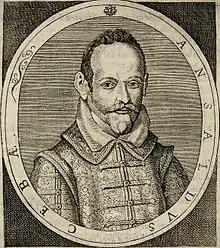Ansaldo Cebà | |
|---|---|
 Portrait of Ansaldo Cebà. From the book "Le glorie degli Incogniti", 1647 | |
| Born | 1565 |
| Died | April 1623 (aged 57–58) |
| Alma mater | University of Padua |
| Occupations |
|
| Writing career | |
| Language | Italian language |
| Period | |
| Genres | |
| Literary movement | |
| Notable works | La reina Esther |
Ansaldo Cebà (1565 – April 1623) was an Italian Baroque poet and literary critic.
Biography
Born to an ancient Genoese family connected with the Grimaldi, Cebà attended the University of Padua, where he studied under Sperone Speroni, and Giason Denores.[1] He specialized in Greek language and literature.[2] On his return to Genoa in 1591 he became a member of the prestigious Accademia degli Addormentati (Academy of the Sleepers), and soon distinguished himself by his academic lectures.[3] He lived most of his life in Genoa.[4] He was ordained a cleric in 1605, after his beloved Geronima Di Negro had become a nun. Cebà was a member of the Accademia degli Incogniti. He died in Genoa in April 1623.[1]
Cebà had an extremely close relationship, by correspondence only, with the jewish poet and writer Sara Copia Sullam, whom he admired but whom he never actually met.[5] He appears to have fallen in love with Sara, and constantly urged her to convert to Christianity, but she resisted.[3] Ansaldo and Sara corresponded from spring 1618 until spring 1622. The correspondence is known through Cebà's Lettere di Ansaldo Cebà scritte a Sarra Copia (Genoa: Giuseppe Pavoni, 1623).
Works
His first book of verse, Rime, appeared in 1596 at Padua and Antwerp. The love-poetry of a Petrarchan stamp which it contained - celebrating a Genoese lady, Aurelia Spinola - gave way in a second volume of Rime (Rome, 1611) to religious and moral themes.[6] At Genoa in 1615 he published an epic poem entitled La reina Esther. The poem was a huge success.[1] Sara Copia Sullam addressed an enthusiastic anonymous letter full of praise to the Genoese poet, telling him that she was so touched by the poem that she slept with it under her pillow.[7] Cebà's epic probably induced Leon of Modena to translate Solomon Usque's tragedy on the same subject from Spanish into Italian verse.[8] Giacomo Lomellini had his palace frescoed by Domenico Fiasella with a cycle of paintings inspired by Cebà's poem.[9]
In 1617 Cebà published his political treatise Cittadino di Repubblica;[10] in 1620 his translation of Theophrastus' Characters. In 1621, also at Genoa, appeared the Esercitii Accademici, and the dialogue Il Gonzaga over del Poema Heroico, in which he tried to prove that Ludovico Ariosto and Torquato Tasso had adhered to the classical unities in their epics.[4] The same year he published also a tragedy, La Principessa Silandra, and the historical treatise Il Principio dell'Historia Romana. A second epic poem, Il Furio Camillo, a second tragedy, Alcippo Spartano, and two volumes of Lettere, came out in 1623, the year of Cebà's death. A third tragedy, Le Gemelle Capovane, was printed for the first time in Scipione Maffei's Teatro Italiano (vol. 2), Verona, 1723.[1]
Notes
- 1 2 3 4 Mutini 1979.
- ↑ Ansaldo Cebà entry (in Italian) by Antonio Belloni in the Enciclopedia italiana, 1931
- 1 2 Sarot 1954, p. 138.
- 1 2 Slawinski 2002.
- ↑ Rio 1856, pp. 74–75.
- ↑ Hutton 1935, p. 360.
- ↑ Westwater, Lynn Lara (2020). Sarra Copia Sulam. A Jewish Salonnière and the Press in Counter-Reformation Venice. University of Toronto Press. p. 21. ISBN 9781487505837.
- ↑ Graetz, Heinrich (1895). History of the Jews. Vol. 5: From the Chmielnicki persecution of the Jews in Poland, 1648 C.E., to the present time, 1870 C.E. Translated by Philipp Bloch. Philadelphia: Jewish Publication Society of America. p. 70.
- ↑ Corradini 1994, p. 147.
- ↑ Il Cittadino di Repubblica was translated into English and published in New York City in 1845. Cf.: Cebà, Ansaldo (1845). The Citizen of a Republic. What are His Rights, His Duties, and Privileges, and what Should be His Education. Translated by Charles Edwards Lester. New York: Paine and Burgess.
Bibliography
- «Ansaldo Cebà Genovese». In : Le glorie de gli Incogniti: o vero, Gli huomini illustri dell'Accademia de' signori Incogniti di Venetia, In Venetia : appresso Francesco Valuasense stampator dell'Accademia, 1647, pp. 70–73 (on-line).
- Rio, Alexis-François (1856). "Ansaldo Ceba, or, the Martyr of Charity". The Four Martyrs. London: Buns & Lambert: 71–102. Retrieved 6 July 2021.
- Bertollotto, G. (1891). "Liguri ellenisti: Ansaldo Cebà" (PDF). Giornale Ligustico di Archeologia, Storia e Letteratura. XVIII: 283–296. Retrieved 14 October 2021.
- Hutton, James (1935). The Greek Anthology in Italy to the Year 1800. Ithaca: Cornell University Press. p. 360.
- Sarot, Eden (1954). "Ansaldo Cebà and Sara Copia Sullam". Italica. 31 (3): 138–150. doi:10.2307/476839. JSTOR 476839.
- Mutini, Claudio (1979). "CEBÀ, Ansaldo". Dizionario Biografico degli Italiani, Volume 23: Cavallucci–Cerretesi (in Italian). Rome: Istituto dell'Enciclopedia Italiana. ISBN 978-8-81200032-6.
- Corradini, Marco (1994). Genova e il barocco. Studi su Angelo Grillo, Ansaldo Cebà, Anton Giulio Brignole Sale. Milan: Vita e pensiero. ISBN 88-343-0452-7.
- Slawinski, M. (2002). "Cebà, Ansaldo". The Oxford Companion to Italian Literature. Oxford University Press. Retrieved 7 June 2023.